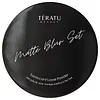What's inside
What's inside
 Key Ingredients
Key Ingredients

 Benefits
Benefits

 Concerns
Concerns

 Ingredients Side-by-side
Ingredients Side-by-side

Mica
Cosmetic ColorantKaolin
AbrasivePolymethyl Methacrylate
Aluminum Starch Octenylsuccinate
AbsorbentOctyldodecyl Stearoyl Stearate
EmollientSilica
AbrasivePolypropylene
Squalane
EmollientPolyethylene
AbrasiveSilica Dimethyl Silylate
EmollientSorbitan Isostearate
EmulsifyingDimethicone
EmollientMethicone
EmollientEthylhexylglycerin
Skin ConditioningGlyceryl Caprylate
EmollientWater
Skin ConditioningMineral Salts
Skin ConditioningButylene Glycol
HumectantCamellia Sinensis Leaf Extract
AntimicrobialPhenoxyethanol
PreservativeCaprylyl Glycol
Emollient1,2-Hexanediol
Skin ConditioningMentha Arvensis Extract
MaskingDisodium EDTA
Acetic Acid
BufferingMica, Kaolin, Polymethyl Methacrylate, Aluminum Starch Octenylsuccinate, Octyldodecyl Stearoyl Stearate, Silica, Polypropylene, Squalane, Polyethylene, Silica Dimethyl Silylate, Sorbitan Isostearate, Dimethicone, Methicone, Ethylhexylglycerin, Glyceryl Caprylate, Water, Mineral Salts, Butylene Glycol, Camellia Sinensis Leaf Extract, Phenoxyethanol, Caprylyl Glycol, 1,2-Hexanediol, Mentha Arvensis Extract, Disodium EDTA, Acetic Acid
Talc
AbrasiveAluminum Starch Octenylsuccinate
AbsorbentMethyl Methacrylate Crosspolymer
Hydrated Silica
AbrasiveNylon-12
Diisostearyl Malate
EmollientIsononyl Isononanoate
EmollientSqualane
EmollientPhenoxyethanol
PreservativeCI 77891
Cosmetic ColorantSalicylic Acid
MaskingTocopheryl Acetate
AntioxidantGlycerin
HumectantCI 77492
Cosmetic ColorantButylene Glycol
HumectantEthylhexylglycerin
Skin ConditioningMelaleuca Alternifolia Leaf Oil
AntioxidantWater
Skin ConditioningCI 77491
Cosmetic ColorantCentella Asiatica Leaf Extract
Skin ConditioningRice Bran/Germ Triterpenoids
Skin ConditioningBioflavonoids
Skin ConditioningSesame Amino Acids
HumectantCI 77499
Cosmetic ColorantAluminum Hydroxide
EmollientHydrogen Dimethicone
Triethoxycaprylylsilane
Talc, Aluminum Starch Octenylsuccinate, Methyl Methacrylate Crosspolymer, Hydrated Silica, Nylon-12, Diisostearyl Malate, Isononyl Isononanoate, Squalane, Phenoxyethanol, CI 77891, Salicylic Acid, Tocopheryl Acetate, Glycerin, CI 77492, Butylene Glycol, Ethylhexylglycerin, Melaleuca Alternifolia Leaf Oil, Water, CI 77491, Centella Asiatica Leaf Extract, Rice Bran/Germ Triterpenoids, Bioflavonoids, Sesame Amino Acids, CI 77499, Aluminum Hydroxide, Hydrogen Dimethicone, Triethoxycaprylylsilane
 Reviews
Reviews

Ingredients Explained
These ingredients are found in both products.
Ingredients higher up in an ingredient list are typically present in a larger amount.
Aluminum Starch Octenylsuccinate is a synthetic powder used as an absorbent, thickener, and anti-caking agent.
As an absorbent, it is great at mattifying skin by soaking up the oil. This is why you'll find it in a range of products from makeup to moisturizers.
This ingredient is considered a modified starch. Starch can also be found naturally in plants.
One study from 1991 found that 5% of this ingredient enhanced titanium dioxide SPF by as much as 40%. The study found 1% titanium dioxide had a 5.6 SPF and adding 5% of aluminum starch octenylsuccinate boosted it to an SPF of 8.1
Although “aluminum” in an ingredient name can raise red flags for some consumers, the form and usage context matter significantly. For typical topical applications, there is no substantial evidence of health risks - such as cancer, neurotoxicity, or systemic “aluminum overload.”
Learn more about Aluminum Starch OctenylsuccinateButylene Glycol (or BG) is used within cosmetic products for a few different reasons:
Overall, Butylene Glycol is a safe and well-rounded ingredient that works well with other ingredients.
Though this ingredient works well with most skin types, some people with sensitive skin may experience a reaction such as allergic rashes, closed comedones, or itchiness.
Learn more about Butylene GlycolEthylhexylglycerin (we can't pronounce this either) is commonly used as a preservative and skin softener. It is derived from glyceryl.
You might see Ethylhexylglycerin often paired with other preservatives such as phenoxyethanol. Ethylhexylglycerin has been found to increase the effectiveness of these other preservatives.
Phenoxyethanol is a preservative that has germicide, antimicrobial, and aromatic properties. Studies show that phenoxyethanol can prevent microbial growth. By itself, it has a scent that is similar to that of a rose.
It's often used in formulations along with Caprylyl Glycol to preserve the shelf life of products.
Squalane is an emollient that helps the skin hold onto moisture. It's an oily liquid that occurs naturally in certain types of fish and plant oils.
Because squalane boosts hydration in the skin, it also comes with plenty of benefits: it is an antioxidant and can help fight free radicals and skin damage. Squalane is also found to have a detoxifying effect when applied.
Squalane comes from squalene, which occurs naturally within the sebum of our skin. It is one of the oils our skin produces to keep itself hydrated. Squalane is the hydrogenated version of squalene and has a longer shelf life.
Research shows that squalane is non-irritating (even at 100% concentration).
In general, it's a fantastic ingredient. It does a great job at hydrating the skin, and it's suitable for those with sensitive skin.
The source of squalane may impact malassezia / fungal acne. This is because olive oil derived squalane can contain impurities such as fatty acids and plant waxes. Sugarcane derived squalane is recommended for anyone with malassezia concerns.
Is squalane vegan?
This depends on the source. Squalane can be derived from both plants and animals. Most squalane used in skincare comes from plants.
Please note: the source of squalane is only known if disclosed by the brand. We recommend reaching out to the brand if you have any questions about their squalane.
Read more about squalene with an "e".
Is squalane an oil?
Squalane is often called an oil, but it’s technically not; it’s a hydrocarbon, meaning it’s only made of carbon and hydrogen, unlike true oils which are triglycerides made of fatty acids and glycerol.
The term “oil-free” isn’t regulated, so companies can define it however they want. Some exclude all oils, while others just avoid mineral oil or comedogenic oils.
While some people avoid oils thinking they cause breakouts, the right kind of oil (or oil-like ingredient like squalane) can actually help balance and hydrate your skin. It’s worth testing out simple oils or squalane to see what works best for your skin.
Learn more about SqualaneWater. It's the most common cosmetic ingredient of all. You'll usually see it at the top of ingredient lists, meaning that it makes up the largest part of the product.
So why is it so popular? Water most often acts as a solvent - this means that it helps dissolve other ingredients into the formulation.
You'll also recognize water as that liquid we all need to stay alive. If you see this, drink a glass of water. Stay hydrated!
Learn more about Water